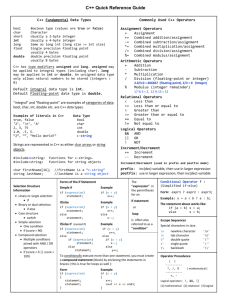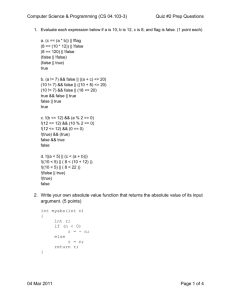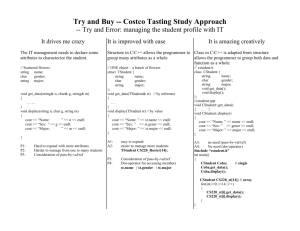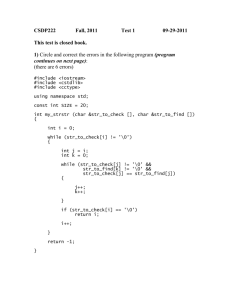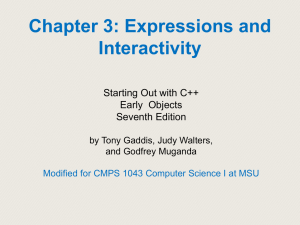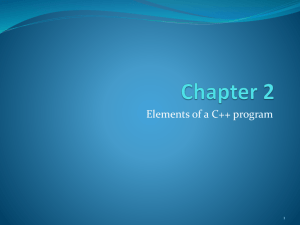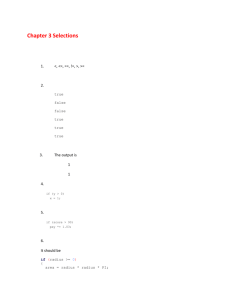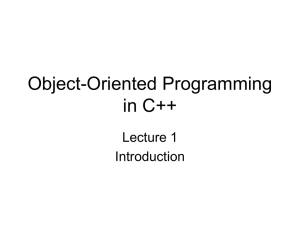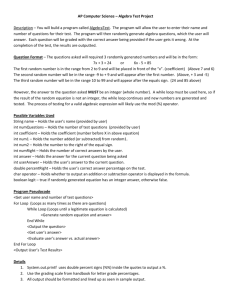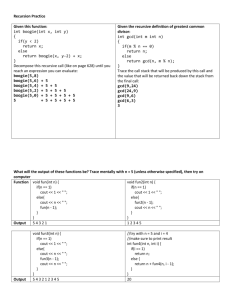C++ Quick Reference Guide: Data Types & Operators
advertisement
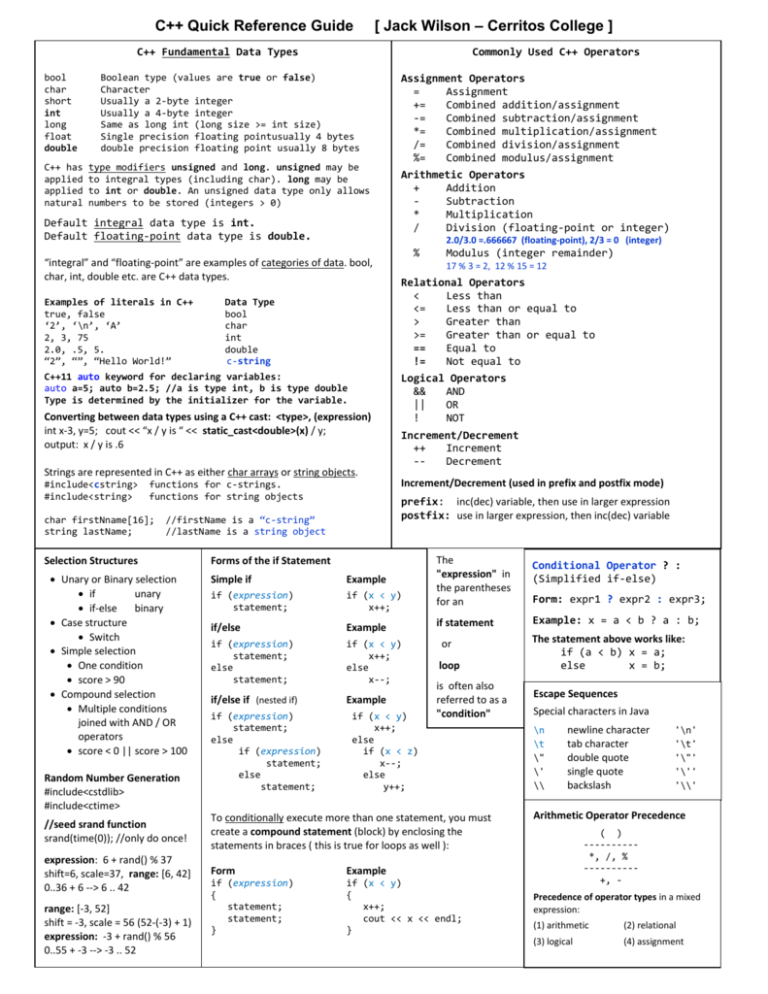
C++ Quick Reference Guide
[ Jack Wilson – Cerritos College ]
C++ Fundamental Data Types
Commonly Used C++ Operators
bool
char
short
int
long
float
double
Boolean type (values are true or false)
Character
Usually a 2-byte integer
Usually a 4-byte integer
Same as long int (long size >= int size)
Single precision floating pointusually 4 bytes
double precision floating point usually 8 bytes
C++ has
applied
applied
natural
type modifiers unsigned and long. unsigned may be
to integral types (including char). long may be
to int or double. An unsigned data type only allows
numbers to be stored (integers > 0)
Default integral data type is int.
Default floating-point data type is double.
Data Type
bool
char
int
double
c-string
C++11 auto keyword for declaring variables:
auto a=5; auto b=2.5; //a is type int, b is type double
Type is determined by the initializer for the variable.
Converting between data types using a C++ cast: <type>, (expression)
int x-3, y=5; cout << “x / y is “ << static_cast<double>(x) / y;
output: x / y is .6
Strings are represented in C++ as either char arrays or string objects.
#include<cstring>
#include<string>
functions for c-strings.
functions for string objects
char firstNname[16];
string lastName;
Unary or Binary selection
if
unary
if-else
binary
Case structure
Switch
Simple selection
One condition
score > 90
Compound selection
Multiple conditions
joined with AND / OR
operators
score < 0 || score > 100
Random Number Generation
#include<cstdlib>
#include<ctime>
%
17 % 3 = 2, 12 % 15 = 12
Relational Operators
<
Less than
<=
Less than or equal to
>
Greater than
>=
Greater than or equal to
==
Equal to
!=
Not equal to
Logical Operators
&&
AND
||
OR
!
NOT
Increment/Decrement
++
Increment
-Decrement
Increment/Decrement (used in prefix and postfix mode)
Forms of the if Statement
Simple if
Example
if (expression)
statement;
if (x < y)
x++;
if/else
Example
if (expression)
statement;
else
statement;
if (x < y)
x++;
else
x--;
if/else if (nested if)
Example
if (expression)
statement;
else
if (expression)
statement;
else
statement;
Modulus (integer remainder)
prefix: inc(dec) variable, then use in larger expression
postfix: use in larger expression, then inc(dec) variable
//firstName is a “c-string”
//lastName is a string object
Selection Structures
Arithmetic Operators
+
Addition
Subtraction
*
Multiplication
/
Division (floating-point or integer)
2.0/3.0 =.666667 (floating-point), 2/3 = 0 (integer)
“integral” and “floating-point” are examples of categories of data. bool,
char, int, double etc. are C++ data types.
Examples of literals in C++
true, false
‘2’, ‘\n’, ‘A’
2, 3, 75
2.0, .5, 5.
“2”, “”, “Hello World!”
Assignment Operators
=
Assignment
+=
Combined addition/assignment
-=
Combined subtraction/assignment
*=
Combined multiplication/assignment
/=
Combined division/assignment
%=
Combined modulus/assignment
if (x < y)
x++;
else
if (x < z)
x--;
else
y++;
The
"expression" in
the parentheses
for an
Conditional Operator ? :
(Simplified if-else)
if statement
Example: x = a < b ? a : b;
or
loop
is often also
referred to as a
"condition"
//seed srand function
srand(time(0)); //only do once!
To conditionally execute more than one statement, you must
create a compound statement (block) by enclosing the
statements in braces ( this is true for loops as well ):
expression: 6 + rand() % 37
shift=6, scale=37, range: [6, 42]
0..36 + 6 --> 6 .. 42
Form
Example
if (expression)
{
statement;
statement;
}
if (x < y)
{
x++;
cout << x << endl;
}
range: [-3, 52]
shift = -3, scale = 56 (52-(-3) + 1)
expression: -3 + rand() % 56
0..55 + -3 --> -3 .. 52
Form: expr1 ? expr2 : expr3;
The statement above works like:
if (a < b) x = a;
else
x = b;
Escape Sequences
Special characters in Java
\n
\t
\"
\'
\\
newline character
tab character
double quote
single quote
backslash
'\n'
'\t'
'\"'
'\''
'\\'
Arithmetic Operator Precedence
( )
---------*, /, %
---------+, Precedence of operator types in a mixed
expression:
(1) arithmetic
(2) relational
(3) logical
(4) assignment
C++ Quick Reference Guide
[ Jack Wilson – Cerritos College ]
Loop Structure Information
The switch/case Construct ( break and default are optional )
C++ Pre-test loops
while, for
C++ Post-test loop
do…while
Loop Control:
Counter-controlled
aka definite loops have
3 expressions:
Initialization, Test, Update
Sentinel-controlled
aka indefinite loops have 2 expressions:
Test ,Update (Alter)
Form:
switch (expression)
{
case int-constant :
statement(s);
[ break; ]
Example:
switch (choice)
{
case 0 :
cout << “You selected 0.” << endl;
break;
case int-constant :
statement(s);
[ break; ]
case 1:
cout << “You selected 1.” << endl;
break;
C++ Loop Early Exit:
break statement
}
default :
cout << “Select 0 or 1.” << endl;
}
The type of the "expression" is integral - usually an expression of type int but it could also be
an expression of type char.
C++ also has a continue statement to skip
statements and proceed to the testexpression.
C++11 ranged for loop:
[ default :
statement; ]
Form:
Use the break keyword to exit the structure (avoid “falling through” other cases).
Use the default keyword to provide a default case if none of the case expressions match
(similar to trailing “else” in an if-else-if statement).
for ( type [&] variable : collection ) stmt;
The collection can be a C-style array, array object, vector object, etc.
array<int, 20> myArray; //declare a 20 element array class object of type int
for (int param : myArray) //would iterate over all 20 elements
Each iteration variable param would be assigned the value of the current element
in myArray. Access to the collection is read-only unless a reference variable is used;
Reference variable example: for (int & param : MyArray)
param *= 2;
The while Loop
Form:
Example:
init;
while (test)
{
statement(s);
update;
}
int x=0;
while (x < 100)
{
cout << x << endl;
x++;
}
Theauto
forkeyword
Loop can be used to declare the parameter (auto [&] param)
The
The do-while Loop
Form:
Example:
Form:
Example:
for (init; test; update)
{
statement;
statement;
}
for (count = 0; count < 10; count++)
{
cout << "The value of count is ";
cout << count << endl;
}
do
do
Using cin / cout
Requires iostream header file: #include<iostream>
Stream Manipulators: Parameterized stream manipulators require: #include<iomanip>
Name
fixed
setprecision( )
setw( ) [not persistent]
left
right
showpoint
scientific
Description
changes mode to fixed -number displays withinteger and decimal
digits
sets the number of significant digits or decimal digits if used in
conjunction with fixed.
sets field width (used for input and output )
sets left justification
sets right justification
forces decimal point & trailing zeros to display
sets scientific notation
statement;
endl;
while (expression);
cout << x++ <<
while (x < 100);
do
{
do
{
statement;
statement;
} while (expression);
cout << x << endl;
x++;
} while (x < 100);
Member functions for input formatting using a stream object
( such as cin )
Name
Description
.getline(array, size)
Reads at most size-1 characters.
Appends '\0'. Stops at '\n' by default.
Consumes the newline character
Creating and using file stream objects: Requires fstream header file: #include<fstream>
Classes
for creating file stream objects Use >> and << operators!
ifstream
create an object for use with an input file
inFile >> num1 >> num2;
ofstream
create an object for use with an output file outFile << sum << endl;
.get(array, size)
Reads at most size-1 characters.
Appends '\0'. Stops at '\n' by default.
Does not consume the newline
character
Member Functions for file stream classes
.open( )
infile.open("data.txt")
.close( )
infile.close()
.get(ch)
.get( )
.ignore( )
.ignore(50,'\n')
.fail( )
.clear( )
.eof( )
.peek( )
.unget( )
infile.fail() test for stream failure ( T/F )
infile.clear() //reset stream status to good
infile.eof() //test for end of file condition ( T/F )
read next character but don't remove it from the input buffer
put last character read back into the input buffer. Replaced the
putback( ) function.
.read(address, size) read fom a binary file
binFile.read(data, sizeof(data));
.write(address,size) write to a binary file
binFile.write(data, sizeof(data));
reads a character ( including whitespace )
reads a character: char = cin.get( );
removes last character entered from buffer
removes last 50 characters from input
buffer or until it sees a newline character
The string class provides a getline( ) function to input a
string. This is not the same as cin.getline( )!
getline(<stream_object>, <string>);
Example: string s; getline(cin, s);

